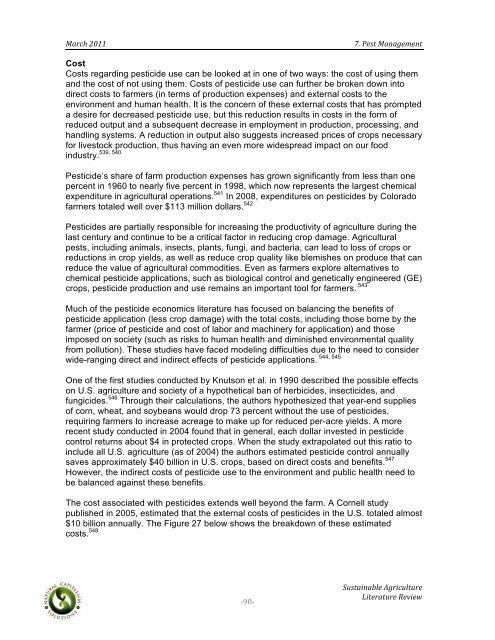Sustainable Agriculture Literature Review - Boulder County
Sustainable Agriculture Literature Review - Boulder County
Sustainable Agriculture Literature Review - Boulder County
Create successful ePaper yourself
Turn your PDF publications into a flip-book with our unique Google optimized e-Paper software.
! ! !!<br />
"#$%&!'())!! !!!!!!!!!!!!!!!!!!!!!!!!!!!!!!!!!!!!!!!!!!!!!!!!!!!!!!!!!!!!!!!!@+!A142!"#5#81B152!<br />
Cost<br />
Costs regarding pesticide use can be looked at in one of two ways: the cost of using them<br />
and the cost of not using them. Costs of pesticide use can further be broken down into<br />
direct costs to farmers (in terms of production expenses) and external costs to the<br />
environment and human health. It is the concern of these external costs that has prompted<br />
a desire for decreased pesticide use, but this reduction results in costs in the form of<br />
reduced output and a subsequent decrease in employment in production, processing, and<br />
handling systems. A reduction in output also suggests increased prices of crops necessary<br />
for livestock production, thus having an even more widespread impact on our food<br />
539, 540<br />
industry.<br />
Pesticide’s share of farm production expenses has grown significantly from less than one<br />
percent in 1960 to nearly five percent in 1998, which now represents the largest chemical<br />
expenditure in agricultural operations. 541 In 2008, expenditures on pesticides by Colorado<br />
farmers totaled well over $113 million dollars. 542<br />
Pesticides are partially responsible for increasing the productivity of agriculture during the<br />
last century and continue to be a critical factor in reducing crop damage. Agricultural<br />
pests, including animals, insects, plants, fungi, and bacteria, can lead to loss of crops or<br />
reductions in crop yields, as well as reduce crop quality like blemishes on produce that can<br />
reduce the value of agricultural commodities. Even as farmers explore alternatives to<br />
chemical pesticide applications, such as biological control and genetically engineered (GE)<br />
crops, pesticide production and use remains an important tool for farmers. 543<br />
Much of the pesticide economics literature has focused on balancing the benefits of<br />
pesticide application (less crop damage) with the total costs, including those borne by the<br />
farmer (price of pesticide and cost of labor and machinery for application) and those<br />
imposed on society (such as risks to human health and diminished environmental quality<br />
from pollution). These studies have faced modeling difficulties due to the need to consider<br />
544, 545<br />
wide-ranging direct and indirect effects of pesticide applications.<br />
One of the first studies conducted by Knutson et al. in 1990 described the possible effects<br />
on U.S. agriculture and society of a hypothetical ban of herbicides, insecticides, and<br />
fungicides. 546 Through their calculations, the authors hypothesized that year-end supplies<br />
of corn, wheat, and soybeans would drop 73 percent without the use of pesticides,<br />
requiring farmers to increase acreage to make up for reduced per-acre yields. A more<br />
recent study conducted in 2004 found that in general, each dollar invested in pesticide<br />
control returns about $4 in protected crops. When the study extrapolated out this ratio to<br />
include all U.S. agriculture (as of 2004) the authors estimated pesticide control annually<br />
saves approximately $40 billion in U.S. crops, based on direct costs and benefits. 547<br />
However, the indirect costs of pesticide use to the environment and public health need to<br />
be balanced against these benefits.<br />
The cost associated with pesticides extends well beyond the farm. A Cornell study<br />
published in 2005, estimated that the external costs of pesticides in the U.S. totaled almost<br />
$10 billion annually. The Figure 27 below shows the breakdown of these estimated<br />
costs. 548<br />
!<br />
"$&"<br />
!,342#.5#6/1!78$.%3/23$1!<br />
9.21$#23$1!:1;.1
















